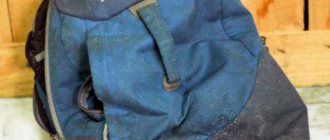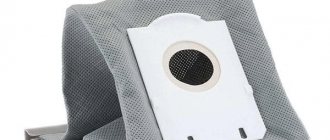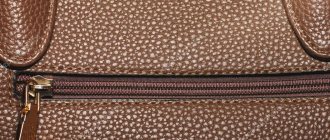Your favorite accessory is dirty! And it seems that he can no longer return to his former appearance. But it turns out that there are ways to clean a backpack made of different materials from any stains and dirt. You will receive all the tools, learn all the secrets to wash your item and keep it beautiful and functional for a long time.
You will learn from our article how to wash a backpack in a washing machine or by hand, where to dry it without damaging the fabric and shape. Tips for caring for a fashion accessory will help you keep it in order and use your favorite item for as long as possible.
Preparing for washing
Before washing a product, it is important to correctly determine the type of material from which it is made. The most problematic are travel backpacks. Firstly, they are large in size, secondly, they “collect” various stains in the field, and thirdly, they are equipped with additional fasteners.
Before washing:
- check pockets and compartments. Remove everything you can find, from important documents to small trash;
- If possible, turn the backpack inside out and shake it out thoroughly;
- if the model has a rigid frame, which does not allow it to be turned inside out, vacuum the bottom and seams;
- unfasten all fasteners and carabiners;
- If you only need a light wash, great! If there are serious contaminants on the surface, they are removed before loading into the washing machine. It is optimal to use a universal stain remover. The powder or liquid mass is distributed on the surface of the contamination and left for half an hour. To remove old stains, it is recommended to rub the product with a soft brush or sponge so that it penetrates deep into the fibers of the fabric;
- Before you set the program, be sure to find a label with recommendations. Not every product can be machine washed. The manual method is recommended for models with fine impregnation against getting wet;
- if there are a large number of metal parts left that cannot be removed, use a special case. This will protect the drum from damage.
Tip : If you don't have a special cover, use a pillowcase of the appropriate size.
If you take on the task of washing a school backpack, do not forget to remove all removable partitions and the thick bottom. Some models have a non-fixed orthopedic back.
Manually
Hand washing a child's school bag is less common than washing it in a machine. If there are difficult stains on the outside or inside, they are treated with a stain remover.
After half an hour, proceed to the main processing:
- Warm water is drawn into a large basin or directly into the bathtub.
- Dilute the detergent.
- Dipping a backpack into the water.
- Using a sponge, clean the briefcase from the outside and inside. It is necessary to act methodically, treating zone by zone.
- After finishing cleaning, you need to rinse the bag on both sides with non-hot water to completely remove any remaining detergent.
- Dry.
Detergents
The choice of product depends entirely on the material of the backpack.
So, for denim, textile and backpacks made of hemp fabric, it is better to use liquid washing powders. It is better to wash tourist clothes with products for membranes and sportswear:
- Salton Sport shampoo. The liquid product allows you to carefully and effectively wash products with various combinations of materials. Suitable for viscose, microphase, elastane and stretch. Preserves the top moisture-repellent layer and the brightness of colors;
- Bionicdry for sports and membrane clothing. The manufacturer calls the main advantage of the product the careful treatment of impregnated fabrics. In addition, the liquid powder does not clog textile micropores and has antimicrobial properties. It has a fairly noticeable aroma that dissipates after a few days;
- NIKWAX Tech Wach. A universal soldier in your cleaning arsenal. It can be used to wash backpacks, awnings, tents, cases and covers made from fabrics such as Gore-Tex, Permatex and Sympa Tex. Not only removes all types of dirt, but also restores the water-repellent barrier of textiles.
Not all backpacks are washable. Manual cleaning is recommended for models made of natural and artificial leather, with embroidery, rhinestone details and designs made using the painting method, as well as tourist ones with a permanent wire frame.
Important Tips
To avoid damaging the product during washing, you must follow the following rules for caring for it:
The product must be washed closed. This applies to zippers, rivets, Velcro and other fasteners.- If the bag is being washed for the first time, then the selected detergent should be tested on an inconspicuous area of the fabric, tracking its reaction.
- For washing, it is recommended to choose the simplest detergents with a minimum content of dyes, fragrances and other aggressive components.
- White backpacks can be soaked in bleach. It is not used for dark and black fabrics.
You need to start removing stains as early as possible. Old stains are more difficult to deal with.
You will find maximum useful information about washing clothes and various fabric products here.
Handwash
If you determine that the item can only be washed by hand, check the information on the label. Most often, the manufacturer places it along the side seam of the main compartment. It indicates the permissible temperature conditions and the possibility of using dry cleaning. If there is no such information and the fabric is unfamiliar to you, you should not wash it in water above 40°C.
- Pre-clean serious stains locally by applying a liquid product to a foam sponge and rubbing into the stain.
- Pour hot water into a large basin and dissolve the detergent, whipping up a voluminous foam. You can wash your travel backpack directly in the bath.
- Place in water for 3-4 minutes and gently scrub the surface with a rag or sponge.
- Rinse under running water. It is necessary to rinse until the water becomes completely clear.
- The school bag does not need to be completely soaked. Turn the lining inside out and wash it in soapy water; wipe the upper part with a damp cloth.
Is it possible to wash the backpack?
Manufacturers most often do not recommend doing this. Most models have a special waterproof impregnation, which gradually washes out when washed. The guaranteed protection of the contents of the backpack from rain and snow is lost, the fabric changes its appearance and becomes less dense. To answer the question about washing, you need to study the product label, which indicates the care parameters. It is located inside the backpack, most often in the largest compartment near one of the side seams. If it states that washing is allowed, go ahead. Just follow the temperature regime and other recommendations. If washing is prohibited, to maintain the appearance of your expensive exclusive or customized travel backpack, it is better to use dry cleaning services.
The product label indicates the care parameters recommended by the manufacturer.
How often to wash
There are two extreme options: not to do it at all or, conversely, very often. In the first case, the backpack accumulates dirt, which becomes more and more difficult to remove over time, and in the second, it wears out faster: the fabric wears out, the dye is washed out, and sometimes deformation occurs. Ultimately, the product loses its attractive appearance in a short period of time. Therefore, you need to wash a backpack as it gets dirty: a school backpack, a city backpack, and any backpack that is used daily - once every 2-3 months, a tourist backpack - 1-2 times a year.
Machine washable
You can wash your backpack in a washing machine if permitted by the manufacturer.
Models made of polyester without leather trim are quite durable and wash well in cold water using the “Delicate Wash” setting. However, the material itself very quickly absorbs odors, including sweat, so it is recommended to clean the backrest and straps more often by hand.
Tarpaulin is the most durable material used in the production of backpacks. The washing mode at high temperatures is suitable for it, but for spinning it is worth setting the minimum drum speed. Dry outdoors upside down.
Jeans require a careful approach. Very often, high temperatures and too aggressive compositions lead to loss of color, the backpack simply fades. This is especially clearly visible on combined models. To wash it, you need a bag or pillowcase, a temperature of no more than 40°C and a minimum spin speed.
Fashionable urban hemp backpacks love water treatments. Exposure to water makes the material softer with each wash. You can wash them in an automatic washing machine, preferably warm water and low spin speed.
How to get rid of the smell?
The easiest way to get rid of the smell is to wash your backpack. If the product cannot be wetted, then resort to the following method:
- Pour soda into fabric bags and secure them so that the powder does not spill out. Activated carbon tablets or salt can be used in the same way.
- Place them in a backpack and leave them for 4-5 days.
- During this time, the soda will absorb all foreign odors.
You can use shoe deodorant by applying it to the inner walls of the product. Dividic neutralizes odors well. It is sold in departments with household chemicals. The price of the bottle is about 150 rubles.
Cleaning different types of backpacks
The method and features of washing a backpack also depend on its design.
School
School bags come in different varieties: orthopedic, purchased mostly for primary school students, and more sporty ones - for high school students. The latter raise virtually no questions, since they do not have a complex system of permanent frames and backs, and are made of materials without bright colors, inert to detergents and cleaning compounds.
If possible, it is better not to wash school frame backpacks entirely, but to clean them inside and out, having previously treated the soiled areas with non-chlorine detergents.
If the frame is removable, like a Kanken backpack, it can even be washed in a washing machine. To do this, you need to unfasten all additional pockets and remove the contents of the compartments. Use a gentle mode with low water temperature, without spinning.
Note! For models with soft foam straps and backrest, the use of bulk cleaning agents is prohibited. They accumulate in the filler and over time can cause allergies in areas of contact with the skin.
Orthopedic
Orthopedic backpacks must be washed using the most gentle cycle without spinning. In this case, the temperature should not exceed 40°C (for models with bright patterns - 30°C).
Before starting the cycle, be sure to check the contents of the pockets, vacuum the backpack, and remove the layer of dust with a damp cloth. Fasten all zippers and place in a case or pillowcase.
After washing, run the delicate rinse cycle twice. Such a backpack should dry on a clothes hanger upside down on a well-ventilated balcony or street.
Tourist
It is necessary to remove the frame and fastenings from the tourist backpack. Turn it inside out so that all non-removable straps are inside, and fasten it. This simple step will protect your washing machine from damage.
Impregnated fabrics (the kind used for travel backpacks) do not tolerate high temperatures well, so choose a heating mode of no more than 30°C with several rinse cycles, without spinning.
Serious contamination will have to be dealt with manually first. Grate the laundry soap and rub it into the dirty area, leave for 20-30 minutes. After this, you can proceed to machine washing.
Leather
Backpacks made of genuine leather must not be washed in a washing machine. For hand washing, first pour warm water into a deep basin, add a soap solution and 3-4 drops of ammonia. Lather the resulting solution thoroughly and soak the foam sponge. Wipe the surface and rinse after removing dirt.
Remove excess moisture with a soft cloth and wipe with castor oil or glycerin. Wipe again with a dry cloth.
Fatty oils help preserve the appearance of the product for as long as possible and prevent the material from cracking.
You can clean a white leather backpack in the same way. However, further treatment is best done with a clear shoe polish, as the oils can leave a yellowish tint on white leather.
A leather backpack made from exotic reptiles can only be washed conditionally. This coating does not absorb moisture, so all actions will be more like wet cleaning. Wipe the product with a slightly moistened sponge; try removing heavy dirt with a paper eraser.
If the backpack is impregnated
It is not recommended to wash a travel bag with impregnation. Manual or machine cleaning will damage the main fabric that protects against moisture. After washing this way, the backpack will become wet and lose its main additional function. If your impregnated hiking bag gets very dirty, you can wash it in the washing machine, but follow a few rules. They will preserve the integrity and functionality of the item.
- You need to take the bottom and frame out of the bag.
- Turn the item inside out so that all the insides (locks, pockets, belts) are fastened and inaccessible.
- Items made from impregnation should not be washed in water above 30 degrees and should not be subjected to a quick spin cycle. On the washing machine, you should set the temperature to 30 degrees, minimal spin, it’s better to do without it altogether.
- Items with a protective membrane cannot be dried using additional means. Manufacturers advise washing without spinning, wait until the water drains naturally and hang the backpack to dry.
Dry and wet cleaning
These types of cleansing are chemical and are performed with special reagents.
The possibility of dry cleaning is indicated on the label by a circle containing one of the letters. The latter defines a reagent that can be used on the fabric:
- P – the most extensive group of reagents, only trichlorethylene is excluded;
- F – use of gentle solvents such as trifluoromethane and hydrocarbon;
- A – any solvent with gentle application.
When dry cleaning, the composition is applied to the contaminated area, left for a certain time and then dried at temperatures up to 50°C. No water is used, either before or after cleaning.
This method has a number of advantages:
- the product is not deformed;
- suitable for backpacks made of leather, suede, draped fabrics;
- copes with old stains that were not removed immediately.
Wet or water cleaning is performed using special equipment. It has significantly more modes than a washing machine. Suitable for removing fresh water-based stains, such as tea or coffee stains on a textile backpack.
How to clean dirt from a backpack that cannot be wet?
Dry cleaning involves avoiding the use of water. Products made of suede, vinyl, wool, Oxford fabric, bags with a permanent frame or with water-repellent impregnation are subjected to this treatment.
You can remove dirt as follows:
Vacuum the backpack outside and inside. This will get rid of dust.- Use starch. Sprinkle it on greasy stains, press lightly and leave for 2-3 hours. The backpack is then vacuumed or the powder is removed using a soft brush.
- Using special brushes. There are devices on sale that allow you to clean backpacks made of suede or nubuck without water.
- Using soda and salt. These components are mixed in equal proportions, applied to the item and left for 1-2 hours. The fabric is then either vacuumed or brushed. This method allows you to get rid of dust, grease stains and unpleasant odors.
If the backpack is expensive, you can take it to the dry cleaner. Professional cleaners will remove dirt from it without harming the fabric.
Removing stains
Before washing your backpack, either by hand or in a washing machine, you need to get rid of as much stubborn dirt as possible, such as grease stains, traces of ink or plasticine.
Grease and heavy soiling
Fresh grease stains can be removed with salt. Sprinkle the trace and leave for 15-20 minutes. You can enhance the effect of the method with the help of corn starch; in this case, the stain is not just sprinkled, but rubbed in thoroughly.
Another effective way is to use dishwashing detergent, because its main purpose is to fight fat. Whip up a thick foam and wet the sponge, wipe the dirt and rinse with clean water.
If a textile backpack without special impregnation has suffered from greasy marks, take several paper napkins, place them on both sides of the fabric and iron them with a hot iron.
Ink
School backpacks are more often affected by the ink of ballpoint and gel pens. Talc, baby powder, starch and even crushed white chalk will not allow a fresh stain to be absorbed into the surface of the material. Sprinkle the contaminated area and leave for 10 minutes, remove any remaining absorbent with a soft towel.
Pen marks on a leather backpack can be removed using medical or ammonia. Apply the liquid to a cotton pad and apply to the stain for 1-2 minutes.
Chewing gum or plasticine
Place a backpack with traces of chewing gum or plasticine in the freezer overnight. If it is very large, apply ice. Freezing makes the gum fragile and allows you to carefully remove it from the fabric without damaging it.
You can get rid of traces of plasticine with isopropyl alcohol, ammonia and WD-40. Removing fats allows the mass to easily come away from the textile.
Our tips for washing a backpack in the washing machine - automatic
To wash your backpack less often, you need to follow a few simple rules.
- First. Purchase products made from quality materials. They will last longer and will not look worse after washing.
- Second. Do not place your bag on the floor. This will make the product more dirty.
- Third. If you need to put dirty things in your backpack, they should first be placed in a bag.
- Fourth. A bag is not a place to collect garbage. Therefore, it must be immediately thrown into the trash bin so that it does not stain the backpack.
- Fifth. If dirt gets on the fabric, it is recommended to immediately wipe it with a damp cloth.
Proper drying
Drying is carried out in a vertical position. Turn the washed backpack inside out and secure it to coat hangers and place it in an area with good air flow. When the lining is dry, turn the product right side out and leave to dry.
Some types of textile backpacks can be ironed, a label inside will tell you this. Be sure to follow the recommended temperature conditions and iron through a cotton cloth to avoid leaving shiny marks on the surface.
Backpacks made of leatherette, genuine leather, and impregnated materials are prohibited from being dried on the fireplace.
The most common stains on school backpacks
Washing is a great way to restore the original appearance of a school backpack.
Most schoolchildren have a particularly active lifestyle. In addition to classroom activities, students play during breaks, visit the school canteen and cafeteria, do physical education, go on excursions, walk, etc. With all these activities, the backpack is exposed to external influences and becomes dirty.
The following may appear on the portfolio:
- traces of ink from ballpoint pens and other writing instruments;
- grease stains from contact with any food products;
- pollution in the form of dust;
- street dirt;
- shoe prints;
- grass stains, etc.
Some materials, when contaminated, are designed exclusively for hand washing. Other fabrics can be washed in any washing device using powder.
Useful tips
The durability of a backpack depends on proper use, care and storage:
- If the product is not used for a long time, store it in a suspended state. First fasten all the zippers, and put an aromatic sachet for clothes inside;
- systematically check the condition of the backpack for any unpleasant odors or mold stains;
- If you get caught in the rain, dry your bag immediately upon arriving home;
- It is easier to deal with contaminants of various natures immediately. Remember that removing old stains will require a lot of effort and time;
- If you have a branded item, do not ignore the care recommendations given by the manufacturer.
We hope the tips were useful to you, and we managed to keep your backpack safe and sound, return it to its decent appearance and extend its service life.
Removing unpleasant odor
During use or after washing the school backpack, an unpleasant odor may remain on it. It's usually hard to deal with. You can hang the product in fresh air. If this does not help, you should use more advanced methods:
- Vinegar – add a couple of tablespoons of 9% vinegar to the water. It neutralizes unpleasant odors. The briefcase needs to be soaked in the solution for half an hour.
- A bag of salt is placed inside the backpack and closed for a couple of hours.
- Activated carbon - tablets must be crushed in a mortar, and then sprinkled with coal on areas that smell bad.
After washing, it is better to hang the backpack in fresh air. This way, the sharp and persistent odors of household chemicals will disappear faster.











